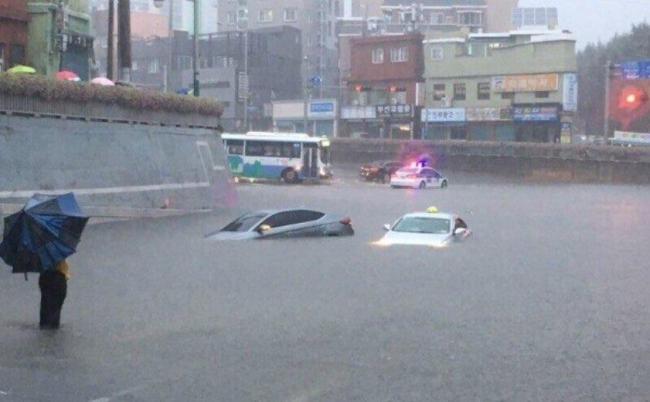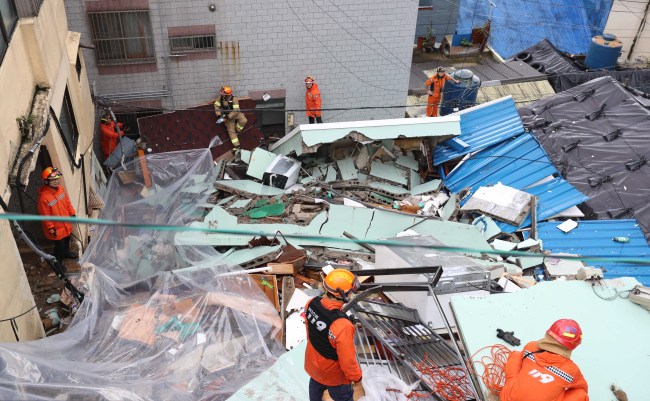Torrential downpours and strong winds hit southern parts of Korea on Monday, flooding streets, shutting down schools, paralyzing traffic and causing power outages.

Geoje and Tongyeong in South Gyeongsang Province and Busan on the south eastern coast were most affected, along with other cities in the Jeolla and Gyeongsang provinces, with some areas seeing up to 308 millimeters of rain, according to the Korea Meteorological Administration.
Busan, the nation’s second-biggest city, had the most rain -- 263.2 mm -- in a day since rainfall began to be measured in 1905. Most of the damage caused by the downpours, or 230 cases, were reported there.

Small buildings collapsed and some 600 elementary, middle and high schools as well as 400 kindergartens were closed. Soil at a construction site was washed away, damaging six cars. At least nine people were rescued after they were trapped in waterlogged buildings or cars. Seven major roads were temporarily shut down.
Some 210 national parks were restricted from access, and 15 flights were canceled.
No deaths were reported.
Heavy showers, which began to batter the southern region early Monday morning, continued through the early afternoon. All the heavy rain warnings in seven cities were lifted as of 12:30 p.m. A heavy rain warning is issued when a region is expected to receive more than 110 mm of rain in six hours or more than 180 mm of rain in 12 hours.
As of noon, Geoje had received the most rainfall of 308 mm, followed by Tongyeong at 273 mm and Busan with 263.2 mm. Seoul and the surrounding Gyeonggi Province were not affected.
After the unexpected downpour, the weather agency came under fire for its failure to predict the rainfall and its botched response.
The weather agency initially forecast more than 30 mm of rain to fall per hour, totaling some 150 mm in southern regions.
Text messages were belatedly sent to citizens to notify them of the restricted roads in Busan, hours after the restriction was lifted. Regional education offices informed students that schools would be temporarily closed at around 8:10 a.m., after some students had already left for school.
The KMA cited the high temperature and humidity, coupled with low atmospheric pressure, as the reason behind the heavier than expected rainfall.
According to a 2017 report from the Board of Audit and Inspection, Korea’s weather agency got about 46 percent of predictions accurate between 2012 and 2015.
(laeticia.ock@heraldcorp.com)
-
Articles by Ock Hyun-ju






![[KH Explains] How should Korea adjust its trade defenses against Chinese EVs?](http://res.heraldm.com/phpwas/restmb_idxmake.php?idx=644&simg=/content/image/2024/04/15/20240415050562_0.jpg&u=20240415144419)












![[Today’s K-pop] Stray Kids to return soon: report](http://res.heraldm.com/phpwas/restmb_idxmake.php?idx=642&simg=/content/image/2024/04/16/20240416050713_0.jpg&u=)